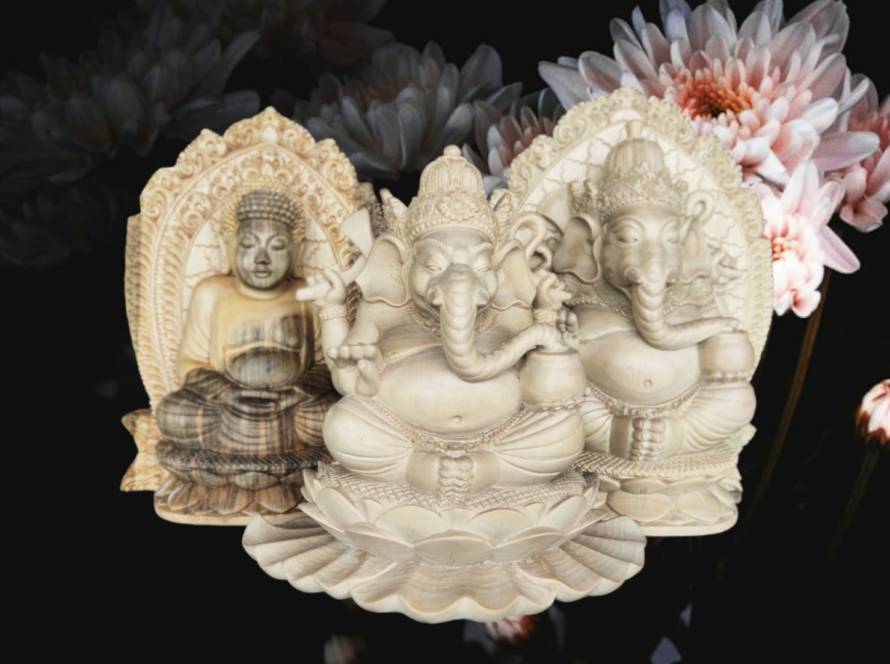The Sacred Journey of Altar Statues
In our fast-paced world, finding moments of peace and spiritual connection can be a challenge. However, for those seeking solace and a deeper connection to their inner selves, a sacred altar statue can help provide a connection to the divine. At the center of this portable sanctuary lies the altar statue – a unique work of art that transcends time and space.Crafting Meaning in Wood
Craftsmanship Beyond Borders
Sacred alter statues are not just symbols of devotion; they are also vessels of culture and tradition. Crafted by skilled artisans from around the globe, each statue tells a story that spans generations. From the intricate carvings of Asia to the delicate brushstrokes of Europe, these statues embody centuries-old craftsmanship and spiritual wisdom.
In Bali skilled artisans meticulously carve altar statues from various types of wood, including sandalwood and teak. These craftsmen often learn their trade from a young age, apprenticing under master carvers to hone their skills and carry on a tradition that stretches back centuries. Each statue is imbued with the cultural heritage and spiritual insight of its creators, making it a unique expression of devotion and craftsmanship.
Similarly, in Western traditions, artisans carve altar statues from locally sourced woods such as oak, maple, and cherry. These statues often depict figures from Christian, pagan, or indigenous spiritual traditions, serving as focal points for prayer, meditation, and contemplation. Whether it’s a depiction of Christ, the Virgin Mary, or a Celtic deity, each statue carries with it a sense of reverence and connection to the divine.
The Enduring Beauty of Wood
Among the materials used to create altar statues, wood holds a special place. Renowned for its warmth, texture, and durability, wood has been favored by artists for millennia. From the sacred forests of Asia to the ancient groves of Europe, artisans have long revered wood as a medium for expressing spiritual truths and divine beauty.
One of the unique qualities of wood is its ability to age gracefully, developing a rich patina that enhances its beauty over time. Unlike more fragile materials such as clay or resin, wood becomes more beautiful with age, deepening in color and texture as it absorbs the essence of its surroundings. This quality makes wooden altar statues ideal companions on life’s journey, evolving alongside their owners as they navigate the twists and turns of existence.
Moreover, wood’s natural warmth and resonance make it an ideal material for altar statues meant to inspire contemplation and connection. Whether carved with intricate details or polished to a smooth finish, wooden statues exude a sense of presence that draws the viewer into a deeper relationship with the divine. In a world filled with distractions and noise, the simple act of gazing upon a wooden altar statue can be a source of solace and inspiration, reminding us of the eternal truths that lie at the heart of existence.
Presence and Connection
Wooden altar statues possess a unique charm that sets them apart. In Bali the statues are carved from sustainable locally sourced wood such as sandalwood, teak or Panggal Buaya, these statues radiate a natural elegance that resonates with the earth’s rhythms. Moreover, wood’s inherent qualities make it an ideal material for altar statues meant to endure for a lifetime, evoking a sense of presence and connection to the divine.
As one gazes upon these timeless works of art, there is a palpable sense of connection – to the divine, to the natural world, and to one’s own innermost being. In a world filled with distractions and noise, the simple act of contemplation becomes a sacred practice, guiding us back to ourselves with each breath. Whether embarking on a spiritual quest or simply seeking solace amidst the chaos, wooden altar statues can serve as steadfast companions, reminding us of the beauty and wisdom that reside within.
• Cultural Homogenization
The proliferation of Western cultural influences and modern technologies poses another challenge to the survival of Indonesian traditional art. As younger generations become more exposed to globalized media and entertainment, there is a risk of cultural homogenization, with traditional art forms being overshadowed by more mainstream and commercially-driven cultural expressions. Without concerted efforts to preserve and promote traditional art, Indonesia risks losing a vital aspect of its cultural heritage.
• Efforts Towards Revitalization
Despite these challenges, there are glimmers of hope on the horizon. Organizations and individuals across Indonesia are working tirelessly to preserve and revitalize traditional art forms. Initiatives range from grassroots efforts to provide training and support to aspiring artisans to government-funded programs aimed at promoting cultural heritage tourism. Additionally, there has been a growing appreciation for authentic, handmade goods among consumers both domestically and internationally, providing new opportunities for traditional artisans to showcase their craft.

